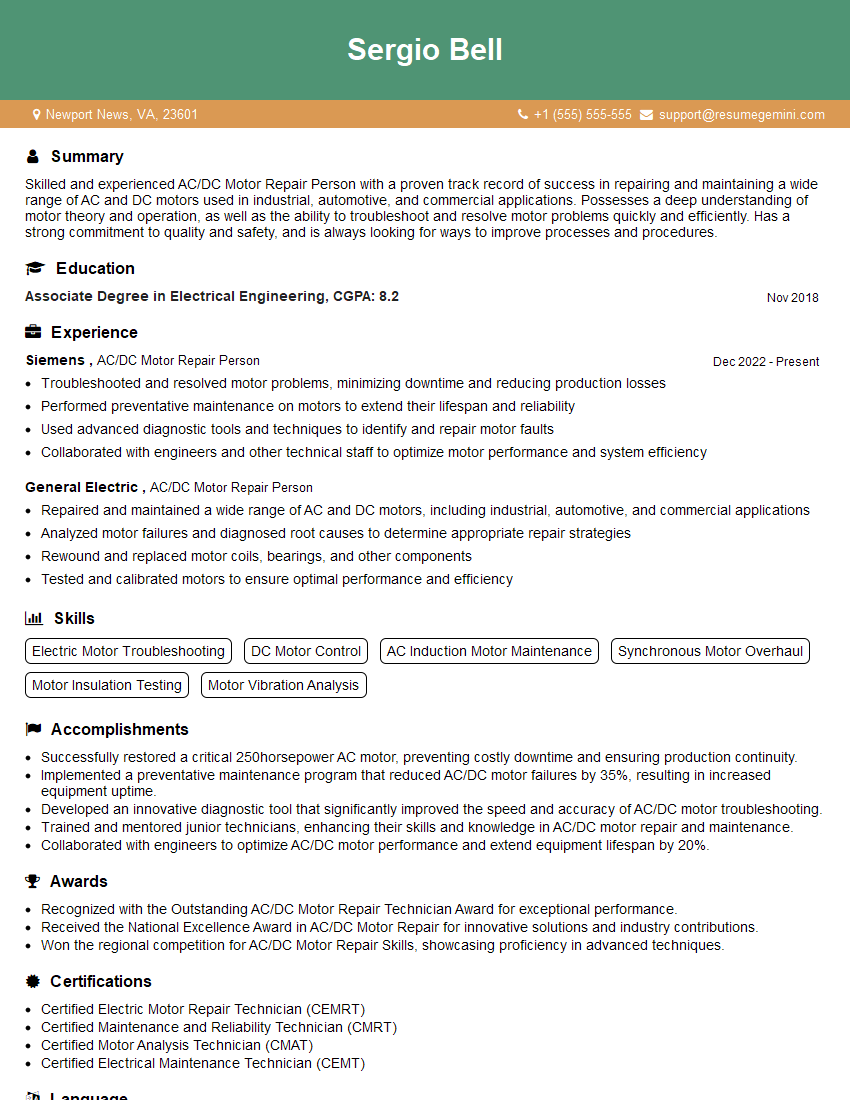Are you a seasoned AC/DC Motor Repair Person seeking a new career path? Discover our professionally built AC/DC Motor Repair Person Resume Template. This time-saving tool provides a solid foundation for your job search. Simply click “Edit Resume” to customize it with your unique experiences and achievements. Customize fonts and colors to match your personal style and increase your chances of landing your dream job. Explore more Resume Templates for additional options.

Sergio Bell
AC/DC Motor Repair Person
Summary
Skilled and experienced AC/DC Motor Repair Person with a proven track record of success in repairing and maintaining a wide range of AC and DC motors used in industrial, automotive, and commercial applications. Possesses a deep understanding of motor theory and operation, as well as the ability to troubleshoot and resolve motor problems quickly and efficiently. Has a strong commitment to quality and safety, and is always looking for ways to improve processes and procedures.
Education
Associate Degree in Electrical Engineering
November 2018
Skills
- Electric Motor Troubleshooting
- DC Motor Control
- AC Induction Motor Maintenance
- Synchronous Motor Overhaul
- Motor Insulation Testing
- Motor Vibration Analysis
Work Experience
AC/DC Motor Repair Person
- Troubleshooted and resolved motor problems, minimizing downtime and reducing production losses
- Performed preventative maintenance on motors to extend their lifespan and reliability
- Used advanced diagnostic tools and techniques to identify and repair motor faults
- Collaborated with engineers and other technical staff to optimize motor performance and system efficiency
AC/DC Motor Repair Person
- Repaired and maintained a wide range of AC and DC motors, including industrial, automotive, and commercial applications
- Analyzed motor failures and diagnosed root causes to determine appropriate repair strategies
- Rewound and replaced motor coils, bearings, and other components
- Tested and calibrated motors to ensure optimal performance and efficiency
Accomplishments
- Successfully restored a critical 250horsepower AC motor, preventing costly downtime and ensuring production continuity.
- Implemented a preventative maintenance program that reduced AC/DC motor failures by 35%, resulting in increased equipment uptime.
- Developed an innovative diagnostic tool that significantly improved the speed and accuracy of AC/DC motor troubleshooting.
- Trained and mentored junior technicians, enhancing their skills and knowledge in AC/DC motor repair and maintenance.
- Collaborated with engineers to optimize AC/DC motor performance and extend equipment lifespan by 20%.
Awards
- Recognized with the Outstanding AC/DC Motor Repair Technician Award for exceptional performance.
- Received the National Excellence Award in AC/DC Motor Repair for innovative solutions and industry contributions.
- Won the regional competition for AC/DC Motor Repair Skills, showcasing proficiency in advanced techniques.
Certificates
- Certified Electric Motor Repair Technician (CEMRT)
- Certified Maintenance and Reliability Technician (CMRT)
- Certified Motor Analysis Technician (CMAT)
- Certified Electrical Maintenance Technician (CEMT)
Career Expert Tips:
- Select the ideal resume template to showcase your professional experience effectively.
- Master the art of resume writing to highlight your unique qualifications and achievements.
- Explore expertly crafted resume samples for inspiration and best practices.
- Build your best resume for free this new year with ResumeGemini. Enjoy exclusive discounts on ATS optimized resume templates.
How To Write Resume For AC/DC Motor Repair Person
- Use specific examples to highlight your skills and experience in motor repair.
- Demonstrate your knowledge of motor theory and operation by using technical terms and concepts correctly.
- Describe your troubleshooting process and how you use diagnostic tools to identify and resolve motor problems.
- Explain how you prioritize your work and meet deadlines, especially in high-pressure situations.
- Proofread your resume carefully for any errors in grammar or spelling.
Essential Experience Highlights for a Strong AC/DC Motor Repair Person Resume
- Diagnose and repair AC and DC motors, including those used in industrial, automotive, and commercial applications
- Analyze motor failures and determine root causes to develop appropriate repair strategies
- Rewind and replace motor coils, bearings, and other components
- Test and calibrate motors to ensure optimal performance and efficiency
- Troubleshoot and resolve motor problems, minimizing downtime and reducing production losses
- Perform preventative maintenance on motors to extend their lifespan and reliability
- Collaborate with engineers and other technical staff to optimize motor performance and system efficiency
Frequently Asked Questions (FAQ’s) For AC/DC Motor Repair Person
What are the most common types of AC and DC motors?
The most common types of AC motors are induction motors, synchronous motors, and brushless DC motors. The most common types of DC motors are brushed DC motors and brushless DC motors.
What are the most common causes of motor failure?
The most common causes of motor failure are bearing failure, winding failure, and insulation failure.
How can I prevent motor failure?
You can prevent motor failure by performing regular preventative maintenance, such as cleaning and inspecting the motor, checking the bearings for wear, and testing the insulation.
What are the benefits of using an AC motor?
AC motors are relatively inexpensive, efficient, and reliable. They are also easy to control and can be used in a wide range of applications.
What are the benefits of using a DC motor?
DC motors offer high torque at low speeds, making them ideal for applications such as electric vehicles and robotics. They are also relatively easy to control and can be used in a wide range of applications.
What is the difference between an induction motor and a synchronous motor?
Induction motors are asynchronous, meaning that the rotor speed is not directly proportional to the stator speed. Synchronous motors are synchronous, meaning that the rotor speed is directly proportional to the stator speed.